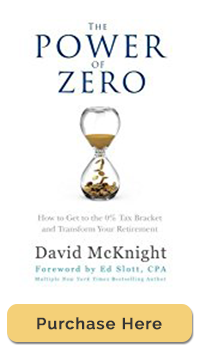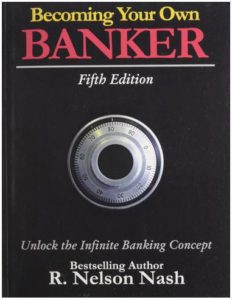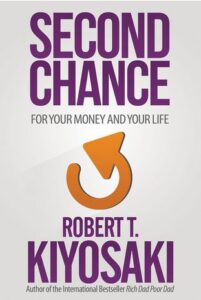Review of The Power of Zero
In The Power of Zero by David McKnight, you have a well written, and popular, book on the tax consequences surrounding most retirement products. McKnight argues that there are three “buckets” of wealth that should be utilized for safe and secure “tax free” retirement planning.
He then provides an example of what he believes is the best type of financial product for the largest of the three “buckets” and presents a case study that showcases all his recommendations in action.
Finally, he wraps up the book with a discussion about the ideal “road map” for achieving success with your personal tax-free retirement plan and answers a few frequently asked questions on the topic.
Initial critique…
While I agree with the foundation of his argument, namely that taxes and market involvement are two of the biggest enemies to a solid retirement plan, I don’t agree with his specific plan for combating those enemies. Having said that, I still think it’s important to evaluate alternative perspectives, and I also believe that much of what McKnight has to say directs people in the right direction.
Social Security is Not the Answer
McKnight sets the stage early on in his book by squashing any hope that readers may have in social security as a solid retirement plan. He states correctly that it was never intended to be a retirement plan but only “insurance against living too long.” His evidence is clear. Social security costs the nation $700 billion per year, or around 20% of the national budget. He also points out that four items in our budget consume 76 cents of every tax dollar; Medicare, Medicaid, social security, and interest on the national debt.
For those that might be planning (i.e. hoping) on social security taking care of them in retirement, The Power of Zero provides ample proof that they should be looking elsewhere. This is where McKnight starts his discussion of the three “buckets” of money that constitute the ideal retirement plan. Stating clearly that the goal should be to allocate the proper amount in each “bucket” so that the result in retirement is that “all your streams of income are tax-free.”
Bucket One – Taxed Investments
The first “bucket” is taxed investments (mutual funds, stocks, CDs, bonds, etc.). For those that are unsure if their investment is taxable, just wait to see if you get a 1099 at the end of the year. The 1099 is essentially a tax bill, meaning that the IRS has been informed that you have earned income and it will be taxed as such.
According to McKnight, this bucket should be used as an emergency fund for six months worth of expenses, because it’s extremely liquid. He states very clearly that the tax consequences of this “bucket” keep it from being the ideal tool to grow significant wealth, but it’s liquidity has value.
This is where I differ from McKnight.
I don’t agree that stocks, bonds, and CDs are good liquid assets. I would propose a cash value life insurance policy as an alternative. The money inside the policy is very liquid, and it doesn’t have some of the other draw backs of market exposure and hidden fees.
To be self-critical, I do think that McKnight makes a valid argument by stating that his three “bucket” plan is solidly diversified, and as such is a hedge against multiple unknown future conditions. I just happen to believe the pros for cash value life insurance outweigh the hedge provided by diversification here.
Moving on…
McKnight also mentions the Ronald Reagan and Tip O’Neill supported law that was passed in ’83 allowing Social Security benefits to be taxed in order to keep the program solvent long-term. The law allowed the IRS to create “thresholds” on your income that would determine if your social security benefits were taxed or not. The type of income that contributes to these “thresholds” is referred to as provisional income.
This is important because not all income is provisional income, and therefore you can earn income that does not contribute to these “thresholds” and thus allows your social security benefits to remain untaxed.
Side note: borrowing from your cash value life insurance policy is not considered provisional income. In actuality it’s not even considered income at all, so much so that the IRS is not even informed of this type of action.
Bucket Two – Tax-Deferred Investments
The second “bucket” is tax-deferred investments, such as 401k Plans, IRAs, etc. McKnight recommends that this should be used up to the employer match, but – and this point is critical – also not to exceed the expected tax-free income limit imposed by the IRS.
What is that limit you ask? Well, these limits are actually fairly easy to hit for many retirees.
Your social security benefits will be completely tax-free if your provisional income is under $25,000, or $32,000 for those filing jointly. For those that have provisional income between $25,000 and $34,000 (single) or between $32,000 and $44,000 (jointly) a full 50% of their benefits are taxed. And finally, for those that make more than $34,000 (single) or $44,000 (jointly) a whopping 85% of their Social Security benefits are taxed. Yikes!
Company Backed Tax Deferred Investments
McKnight is correct that a company backed tax-deferred investment that offers a good match is a welcome asset. However, if this account gets too large, the required minimum distributions (RMD) can cause serious tax consequences. McKnight points out the challenge to accurately creating a plan for this second bucket, and strongly recommends a tax-free investment advisor for such.
I think McKnight does an excellent job of providing the reader with information that many investment advisors fail to mention to those people investing in their prime accumulation years. Many people assume that the company match 401k is a no-brainer. But the reality is that it may have consequences down the road that typical tax-deferred investment advisors ignore.
An example can be provided of a couple that exceeded the provisional income threshold by just $1,000. And as a result, they suffered a tax consequence of an additional 35% of their Social Security benefits being taxed. The consequence would be around $3,200. In other words, had they distributed just $1,000 less from their 401k, they would have paid $3,200 less in taxes.
This is just an example, but most are unaware that this type of thing is an issue in retirement. His recommendation for a tax-free investment advisor is welcome advice on this point. The rule of thumb from McKnight is that you should invest up to the employer match, but nothing more.
Bucket Three – Tax-Free Investments
The third “bucket” is tax-free investments (LIRP – Life Insurance Retirement Plan, Roth IRA). This final “bucket” should be used to grow the retirement account as much as possible in a tax-free “bucket.” This is where McKnight really shares the bulk of his information. Many people are unfamiliar with the benefits of a LIRP and McKnight provides an excellent resource on this point. I would even push the point a little further and suggest that individuals seek out specific cash value life insurance policies from a reputable mutual insurance company.
Will taxes go down or up?
McKnight makes a strong case for the belief that tax rates will increase in the future. And he also stresses that most retirees have higher taxable income during retirement, not lower. This is a bit surprising to many, but is a result of the fact that retirees have less deductions. As a result McKnight recommends investing in a cash value life insurance product that provides the least amount of insurance the IRS requires, while flooding the policy with additional money up to the IRS limit.
What McKnight is describing is a typical strategy for overfunding a cash value life insurance policy using certain strategies, such as paid up additions. This strategy allows the individual to reap the significant tax benefits from the insurance policy, while also keeping the costs low (because the policy owner is not actually buying that much insurance).
McKnight also shares with the reader the fact that there is no income limit on this strategy, and that is likely why you see 85% of Fortune 500 CEOs investing is this type of strategy as a primary tool for their retirement.
4 Characteristics
The ideal insurance company according to McKnight has the following four characteristics:
1. Low expenses: Expenses eat into your savings!
2. Long-term care provisions: Carriers do not always offer a long-term care provision, and some that do charge way too much.
3. Cost-free distributions: You can always get your money out tax-free, but it’s not always cost-free.
4. Financial stability: Find a company that has a long track record of success.
The book wraps up with an encouragement to seek help in developing a road-map for retirement success. It is clear to the reader that the challenge is getting the right amount of money into each bucket, and that challenge is best handled with experienced help.
Final Thoughts
All in all a good book that really highlights the consequences of income tax on retirement accounts. However, it doesn’t even discuss many of the pros and cons of market exposed investments vs. dividend paying life insurance policies.
So there is a big piece of the equation that is left out of all the examples.
Also, almost all examples in the book assume an 8% annual rate of return, something that is clearly not the case.
However, the book is all about tax consequences, so the reader shouldn’t be surprised when some aspects of the argument are left untouched.
There is plenty to learn from this book, and McKnight does a solid job of communicating the devastating impact of taxes on the retirement accounts of the unprepared. For those that are seeking to pave their own road, this book is one of the many you should read. For those that want to leverage the time and expertise of others, I highly recommend a tax-free investment advisor, such as an Infinite Banking Strategist, such as the experts at insuranceandestates.com.






